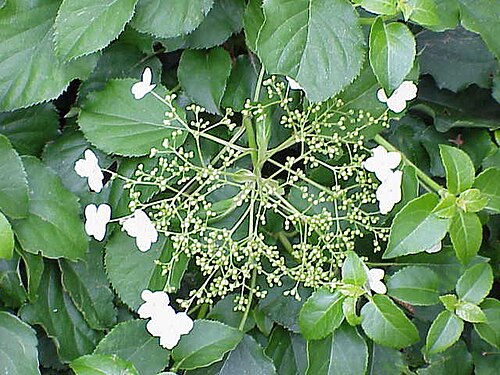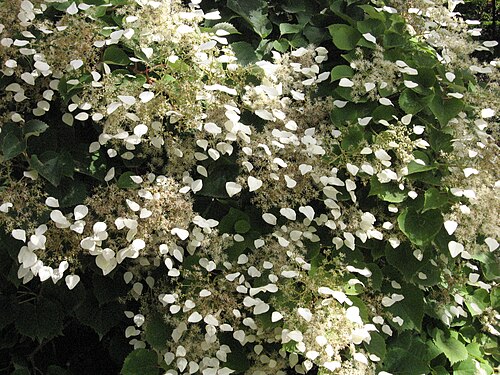Difference between revisions of "Schizophragma"
| Line 7: | Line 7: | ||
|Temp Metric=°F | |Temp Metric=°F | ||
|jumpin=If this plant info box on watering; zones; height; etc. is mostly empty you can click on the edit tab and fill in the blanks! | |jumpin=If this plant info box on watering; zones; height; etc. is mostly empty you can click on the edit tab and fill in the blanks! | ||
| − | |image= | + | |image=Schizophragma hydrangeoides branch.png |
| − | |image_width= | + | |image_width=200 |
}} | }} | ||
| + | '''''Schizophragma''''' is a genus of four species of [[liana]]s in the [[Hydrangeaceae]], native to [[Asia]] from the [[Himalaya]] east to [[Taiwan]] and [[Japan]]. One species, ''S. hydrangeoides'', is known as Climbing Hydrangea Vine. | ||
| + | |||
{{Inc| | {{Inc| | ||
Schizophragma (Greek, schizein, to cleave, and phragma, wall; the inner layer of the wall of the valves is cleft into fascicled fibers). Saxifragaceae. Ornamental vines grown for their handsome bright green foliage and their showy clusters of white flowers. | Schizophragma (Greek, schizein, to cleave, and phragma, wall; the inner layer of the wall of the valves is cleft into fascicled fibers). Saxifragaceae. Ornamental vines grown for their handsome bright green foliage and their showy clusters of white flowers. | ||
| Line 18: | Line 20: | ||
}} | }} | ||
| − | + | ==Cultivation== | |
| − | + | ||
| − | + | ||
| − | + | ===Propagation=== | |
| − | + | ||
| − | + | ||
| − | + | ===Pests and diseases=== | |
| − | + | ||
| − | + | ||
| − | + | ==Species== | |
| − | |||
| − | |||
| − | |||
| − | |||
| − | |||
Four species, including:<br/> | Four species, including:<br/> | ||
| − | ''Schizophragma hydrangeoides''<br/> | + | ''[[Schizophragma hydrangeoides]]''<br/> |
| − | ''Schizophragma integrifolium'' | + | ''[[Schizophragma integrifolium]]'' |
| − | }} | + | |
| + | ==Gallery== | ||
| + | <gallery perrow=5> | ||
| + | File:Schizophragma integrifolia1.jpg | ||
| + | File:Schizophragma hydrangeoides 2.JPG | ||
| + | File:Schizophragma hydrangeoides 3.JPG | ||
| + | </gallery> | ||
| + | |||
| + | ==References== | ||
| + | <references/> | ||
| + | *[[Standard Cyclopedia of Horticulture]], by L. H. Bailey, MacMillan Co., 1963 | ||
| + | <!--- xxxxx *Flora: The Gardener's Bible, by Sean Hogan. Global Book Publishing, 2003. ISBN 0881925381 --> | ||
| + | <!--- xxxxx *American Horticultural Society: A-Z Encyclopedia of Garden Plants, by Christopher Brickell, Judith D. Zuk. 1996. ISBN 0789419432 --> | ||
| + | <!--- xxxxx *Sunset National Garden Book. Sunset Books, Inc., 1997. ISBN 0376038608 --> | ||
| + | |||
| + | ==External links== | ||
| + | *{{wplink}} | ||
| − | + | {{stub}} | |
| + | __NOTOC__ | ||
Latest revision as of 16:13, 21 May 2010
| Habit | vine-climber |
|---|
| Features: | ✓ | deciduous |
|---|
If this plant info box on watering; zones; height; etc. is mostly empty you can click on the edit tab and fill in the blanks!
Schizophragma is a genus of four species of lianas in the Hydrangeaceae, native to Asia from the Himalaya east to Taiwan and Japan. One species, S. hydrangeoides, is known as Climbing Hydrangea Vine.
Read about Schizophragma in the Standard Cyclopedia of Horticulture
|
|---|
|
Schizophragma (Greek, schizein, to cleave, and phragma, wall; the inner layer of the wall of the valves is cleft into fascicled fibers). Saxifragaceae. Ornamental vines grown for their handsome bright green foliage and their showy clusters of white flowers. Shrubs climbing by aerial rootlets: lvs. opposite, long-petioled, dentate or entire: fls. in loose cymes; sepals and petals 4-5; stamens 10; style 1; ovary 4-5-loculed; marginal sterile fls. consist only of 1 large white sepal, terminating the branchlets of the infl.: fr. a small, 10-ribbed caps.—One species in Japan and another in China, allied to Hydrangea and Decumaria. These are handsome woody vines with rather large bright green foliage and loose terminal cymes of small white flowers with large and showy sterile ones at the margin. They are well adapted for covering walls and trunks of trees and cling firmly by means of aerial rootlets. The Japanese species is hardy as far north as New York City, while the Chinese one is tenderer. They thrive best in rich, moderately moist soil and partial shade, but also do well in full sun if the soil is not too dry. Propagation is by seeds or greenwood cuttings under glass; also by layers.
|
Cultivation
Propagation
Pests and diseases
Species
Four species, including:
Schizophragma hydrangeoides
Schizophragma integrifolium
Gallery
References
- Standard Cyclopedia of Horticulture, by L. H. Bailey, MacMillan Co., 1963
External links
- w:Schizophragma. Some of the material on this page may be from Wikipedia, under the Creative Commons license.
- Schizophragma QR Code (Size 50, 100, 200, 500)



